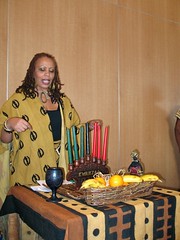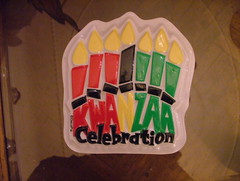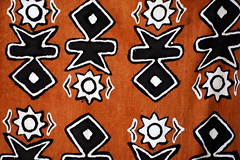Found on flickrcc.net
Kwanzaa began in 1966 by Dr. Maulana Karenga. Dr. Karenga was concerned at the loss of identity of The African American people and wanted a celebration of their cultural heritage and roots.
This holiday reinforces community, family and good social values. The community comes together to teach young people to be proud of who they are and reaffirm the commitment to family and community. Kwanzaa begins on December 26 and lasts for seven days.
The word kwanzaa is Swahili. The origin comes from an ancient African tradition of celebrating the first fruits.
Principles
Found on flickrcc.net
Each day of Kwanzaa has a different theme or value.
Umoja (unity) To come together as a family, community,
nation, and race.
Kujichagulia (self-determination) To have a separate
identity and to let others know about it.
Ujima (cooperation) To build a community and solve problems
together.
Ujamaa (support) To build business and places of work
especially to support others in the community.
Nia (purpose) To rebuild the community ties and maintain
them.
Kuumba (creativity) To improve the community and make it a
better and more beautiful place.
Imani (Faith) In the leaders and the community.
Symbols

This holiday has many symbols.
The candleholder, or the kinara, holds seven candles.
The center candle is black to symbolize the face of the
African people. Three red candles (symbolizing the blood of the people) are to
the left, and three green candles (symbolizing the land and hope of new life)
are to the right.
A table is covered with a piece of African cloth. On top of the cloth is a straw mat, or mkeka. The
kinara is placed on the mat.
For every child, an ear of corn, or muhindi, is placed on
the mat. There is also a cup of unity (kikombe cha umoja)
Celebration

Image: 'Lighting of the candles'
http://www.flickr.com/photos/46141808@N07/4445464598
Found on flickrcc.net
http://www.flickr.com/photos/46141808@N07/4445464598
Found on flickrcc.net
Each day, the family, or several families, gather to discuss
the principle of the day. Traditionally, the youngest person lights the candle.
Starting with the black candle in the center.
After the discussion, the candle is put out.
The next day, the black candle is lit again, and then a red
candle for the next principle. The red and green candles are alternated on the
remaining nights.
On the last night, a karumu, or feast is held. Authentic
African food, dancing, story telling and stories about Kwanzaa. Everyone drinks
from the Cup of Unity. Gifts of books, heritage symbols, and homemade crafts
are usually given to the children. Some celebrations may include drumming and musical selections.
Decorations

http://www.flickr.com/photos/79891443@N00/2162340671
Found on flickrcc.net
Homes are decorated with objects of art and colorful African cloth such as kente.
Celebrants wear dashiki (shirt or suit) Kaftans (dress) and Kufi
(cap) made of the cloth.

Image: 'Cloth with african pattern'
http://www.flickr.com/photos/58836902@N00/614724494
Found on flickrcc.net
http://www.flickr.com/photos/58836902@N00/614724494
Found on flickrcc.net
The greeting is ‘Joyous Kwanzaa.'
Do you celebrate Kwanzaa? Why don't you share your favorite tradition with us all?



No comments:
Post a Comment
Thanks for your comments. I LOVE hearing from you! :D